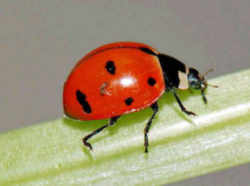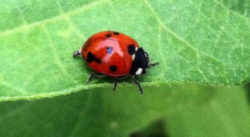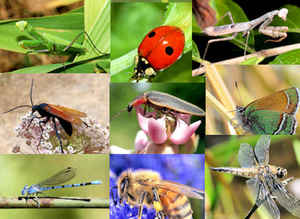New York State Insect
Ladybug

(Coccinella novemnotata)
Adopted in 1989.
The ladybug, (Coccinella novemnotata,) is an orange beetle with black spots. It helps gardeners by eating tiny pests that ruin plants. The ladybug was adopted as New York State insect in 1989.
The Ladybug is the Official State Insect of six states; New York, North Dakota, Ohio, Massachusetts, New Hampshire and Tennessee. The Lady Bug is the Official State "Bug" of Delaware.
New York State Insect: Ladybug

Coccinella novemnotata, the nine-spotted ladybug or nine-spotted lady beetle, is a species of ladybug native to North America. This beetle was dedicated to the Virgin Mary and called "Beetle of Our Lady." They are around four-tenths of an inch long, brightly colored, round, with the popular ladybug having four black spots on each wing. Ladybugs are sold to farmers to control insect pests because they are important aphid predators. The life cycle is about four weeks as the ladybug larvae passes through four growth stages feeding on insects and insect eggs. The reddish-orange ladybug has distinctive black spots on each wing cover.
It helps farmers by controlling insect pests, especially aphids. In folk medicine, ladybugs were believed to cure various diseases such as colic and measles. In folk medicine ladybug beetles were used to cure various diseases including colic and the measles.
Characteristics of the New York Ladybug
Adults
The nine-spotted ladybug can be identified by the presence of four black spots on each of its elytra, a single spot split between the elytra, and a black suture between the elytra. Its pronotum is black, with two connected white marks at the front of its .7x.83 head..
Defense
Bright colors generally indicate that the insect is armed and dangerous! In this case the ladybird is advertising it's bitter taste. When handled the ladybird will exude drops of pungent fluid which stain the hand and taint it with a long-lasting smell.
Feeding
As with most in this family, ladybirds will eat huge numbers of aphids in both the larval and adult stages
LARVA
carnivorous, aphids
Some Facts About Ladybugs:
- Ladybugs are the most popular and widely used beneficial insects for commercial and home use. Ladybugs are capable of consuming up to 50 to 60 aphids per day but will also eat a variety of other insects and larvae including scales, mealy bugs, leaf hoppers, mites, and various types of soft-bodied insects, and are one of the most active predators, searching from dawn to dusk for food.
- Ladybugs will consume over 5,000 aphids each in their lifetime. Pollen and nectar are necessary for maturation of newly emerged ladybug adults, particularly before a winter hibernation season. Adults can survive on pollen and nectar for limited periods, but a supply of aphids or other prey is necessary for egg production.
- Ladybugs become active at about 59 degrees Fahrenheit.
- Ladybugs are cold-blooded and hibernate in cold weather.
- There are nearly 5,000 different kinds of ladybugs worldwide - 400 of which live in North America.
- A ladybug's top flying speed is about fifteen miles per hour.
- Ladybugs lay their eggs where aphids are present. Both lady bugs and their larvae eat aphids. The eggs of ladybugs are not visible to the naked eye.
- A female ladybug will lay more than 1000 eggs in her lifetime.
- Ladybugs are a type of beetle. All species of ladybugs have short legs. This separates them from other beetles.
- Ladybugs chew from side to side and not up and down like people do.
- The Ladybug is the Official State Insect of six states; New York, North Dakota, Ohio, Massachusetts, New Hampshire and Tennessee. The Lady Bug is the Official State "Bug" of Delaware.
- A ladybug excretes a yellowish liquid when it is threatened. The liquid has a terrible smell to its predators.
- The Asian Lady "Beetle" can live up to 2-3 years if the conditions are right.
New York Law
The law designating the lady bug as the official New York state insect is found in the New York State Consolidated Laws, STL, Article 6, Section 86.
STL - State
ARTICLE 6 - ARMS AND GREAT SEAL OF STATE
SECTION 86
§ 86. State insect. The lady bug (Coccinella novemnotata) shall be the official insect of the state of New York.
Taxonomic Hierarchy: Lady Bug
Kingdom: Animalia (Animals)
Phylum: Arthropoda (Arthropods)
Subphylum: Hexapoda (Hexapods)
Class: Insecta (Insects)
Order: Coleoptera (Beetles)
Suborder: Polyphaga (Water, Rove, Scarab, Long-horned, Leaf and Snout Beetles)
No Taxon: (Series Cucujiformia)
Superfamily: Coccinelloidea
No Taxon: (Coccinellid group)
Family: Coccinellidae (Lady Beetles)
Subfamily: Coccinellinae
Genus: Coccinella
No Taxon: (narrow black elytral suture)
Species: novemnotata (Nine-spotted Lady Beetle)
Butterflies, and Bugs








